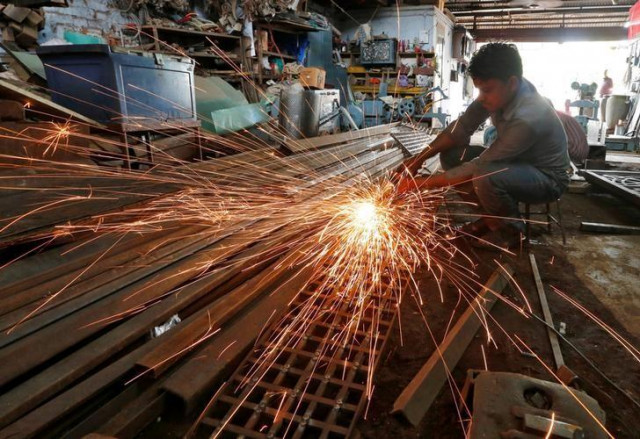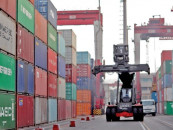Pakistan needs to set performance targets for investment in manufacturing sector
Industrial policies should cover participation in global value chains, alleviating poverty through employment

A worker grinds a metal gate inside a household furniture manufacturing factory. PHOTO: REUTERS
Unfortunately, Pakistan’s growth rate has been considerably lower than its regional peers. The State Bank of Pakistan (SBP) expects the real gross domestic product (GDP) growth rate to be around 3.5% in the current fiscal year.
The slow GDP growth is a source of major concern. The economy faces challenges on several fronts. Although the balance of payments crisis and the fiscal deficit must be addressed, the lack of investment and savings demands equal attention as well.
As the debate continues as to how Pakistan may achieve better economic growth, several experts have correctly identified the immediate need for economic stability to attract investment and propel growth. Currently, the balance of payments crisis, rising discount rate and growing fiscal deficit have exacerbated the economic woes. The expected IMF package can help alleviate some concerns.
As mentioned earlier, the lack of adequate investment in Pakistan has been contributing to adverse economic conditions. According to data from the World Development Indicators, Pakistan reported the gross fixed capital formation (GFCF) as a percentage of GDP, which indicates the level of investment outlay, at 14.5% in 2017. In comparison, the average for the South Asian region was 27.2%. In 2011, the value for Pakistan was 12.5%, the lowest since 1973. On the other hand, the average for the South Asian region peaked at 32.7% in 2007.
If we consider the GFCF in the private sector, the number for Pakistan was even more dismal at 10% of GDP in 2017. It peaked in the mid-2000s, the period when Pakistan’s GDP also grew at the fastest pace in the past 20 years. The South Asian average for GFCF in the private sector in 2017 was 23.2%.
Gross savings for Pakistan at 20% of GDP are also considerably lower than the South Asian average of 30.1%. The average for the least developed countries (LDCs), the group of most economically vulnerable countries, is higher at 26%. However, in the mid-2000s, Pakistan had closed the gap between itself and its regional counterparts as it achieved savings rates above 25%.
The collapse in gross savings as a percentage of GDP started post-2005 as the country went through a phase of higher inflation coupled with a growing balance of payments crisis.
Manufacturing sector
Sustained investments in manufacturing activities are crucial. Value addition by the manufacturing sector as a percentage of GDP in Pakistan was the highest ever in 2005, peaking at 17.5%. It was the only instance in the last four decades when the value addition beat the average for the South Asian region.
Unfortunately, this increase could not be sustained as the value addition collapsed to 13% in 2016. In 2017, it was below 12%. The average for the South Asian region was 14.8% in 2017.
Adding to the woes, the data on national accounts, reported by the UN Statistics Division, showed that the final consumption expenditure was 93.7% of Pakistan’s GDP. In comparison, the average for the South Asian region was 71.7%. De-industrialisation in Pakistan along with an unsustainable preference for consumption needs to be reverted with policies that promote investment in the manufacturing sector.
Pakistan is one of the largest producers of cotton in the world and the textile industry is the largest contributor to GDP within the manufacturing sector. Hence, its contribution to the economy cannot be discounted. However, the investment by domestic producers has lagged behind compared to other countries, which have experienced significant gains in textile exports in recent years.
According to the data extracted from the ITC’s Trademap.org, between 2003 and 2006, Pakistan imported $2.3 billion of textile machinery. However, between 2007 and 2012, the total imports of textile machinery decreased to $1.96 billion. Even between 2015 and 2018, when Pakistan benefited from the GSP Plus status from the European Union and export enhancement programmes offering a boost to textile exports, total imports of textile machinery stood at only $1.72 billion.
In 2005, Pakistan imported more textile machinery than Bangladesh and Vietnam combined. In 2017, the value was almost 60% of what reported by Vietnam and 67% of the figure reported by Bangladesh.
In 2005, textile exports from Pakistan were higher than exports from both Bangladesh and Vietnam. In 2017, the two countries considerably outperformed Pakistan. The lack of new investments in the textile industry has contributed to the decline in exports.
Foreign direct investment (FDI) inflow into Pakistan, as reported by the World Investment Report 2018 prepared by UNCTAD, peaked in the mid-2000s. Pakistan reported approximately $5.6 billion of foreign investment inflow in 2007. In 2012, the amount had decreased to just $860 million, the lowest since 2004.
Although the amount recovered to more than $2.8 billion in 2017, the South Asian region received $52 billion. However, it is important to note that with the advent of CPEC in 2015, several Greenfield FDI projects were announced in Pakistan.
With several new investment projects by various trading partners being announced in the current fiscal year as well, a quick implementation of such projects is crucial. However, a majority of the foreign investment inflow into Pakistan in recent years was primarily in the power and construction sectors. The preference should now shift towards the manufacturing sector.
It is imperative that Pakistan introduces incentives as well as performance requirements to promote export-oriented investment in the manufacturing sector. Although various incentives are commonly provided for new investments, it is crucial that incentives are linked to the performance targets, which not only emphasise the need for local employment but also for export performance.
Foreign investors must be required to meet foreign standards and production requirements. As the World Investment 2018 Report recommends, it is essential that industrial policies cover a myriad of objectives, such as participation in global value chains and alleviation of poverty through employment and production linkages with small and medium enterprises.
The writer is the Assistant Professor of Economics and Research Fellow at CBER, IBA
Published in The Express Tribune, April 8th, 2019.
Like Business on Facebook, follow @TribuneBiz on Twitter to stay informed and join in the conversation.



















COMMENTS
Comments are moderated and generally will be posted if they are on-topic and not abusive.
For more information, please see our Comments FAQ